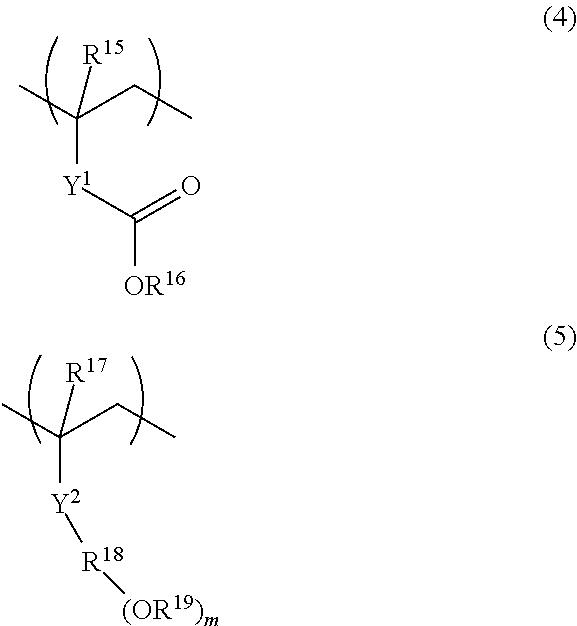Polymer, resist composition, and pattern forming process
a composition and resist technology, applied in the field of polymer, resist composition, and pattern forming process, can solve the problems of expected resolution performance not being obtainable, and onium salt decomposition also occurring, so as to inhibit the concomitant deprotection reaction and minimize the roughness of the edge
- Summary
- Abstract
- Description
- Claims
- Application Information
AI Technical Summary
Benefits of technology
Problems solved by technology
Method used
Image
Examples
example 1
[0105]Under illumination of Tino4000NY, a 2-L flask was charged with 8.2 g of 3-ethyl-3-exo-tetracyclo[4.4.0.12,5.17,10]-dodecanyl methacrylate, 3.6 g of 4-hydroxyphenyl methacrylate, 9.0 g of 3-oxo-2,7-dioxatricyclo[4.2.1.04,8]nonan-9-yl methacrylate, 5.6 g of PAG Monomer 1, 0.1 g of 1-(t-pentyloxycarbonyl)-4-morpholine, and 40 g of tetrahydrofuran (THF) as solvent. Under nitrogen atmosphere, the reactor was cooled to −70° C., after which vacuum pumping and nitrogen blow were repeated three times. The reactor was warmed up to room temperature, whereupon 1.2 g of 2,2′-azobisisobutyronitrile (AIBN) was added as polymerization initiator. The reactor was heated at 60° C., whereupon reaction run for 15 hours. The reaction solution was poured into 1 L of isopropyl alcohol for precipitation. The resulting white solid was filtered and vacuum dried at 60° C., obtaining a white polymer designated Polymer 1. The polymer was analyzed by 13C-NMR and 1H-NMR spectroscopy and GPC, with the results...
example 2
[0107]Under illumination of Tino4000NY, a 2-L flask was charged with 9.8 g of 3-isopropyl-3-cyclopentyl methacrylate, 9.9 g of β-methacryloxy-β,γ-dimethyl-γ-butyrolactone, 3.7 g of PAG Monomer 2, 0.1 g of 1-(t-butoxycarbonyl)-4-piperidinone, and 40 g of THF solvent. Under nitrogen atmosphere, the reactor was cooled to −70° C., after which vacuum pumping and nitrogen blow were repeated three times. The reactor was warmed up to room temperature, whereupon 1.2 g of AIBN was added as polymerization initiator. The reactor was heated at 60° C., whereupon reaction run for 15 hours. The reaction solution was poured into 1 L of isopropyl alcohol for precipitation. The resulting white solid was filtered and vacuum dried at 60° C., obtaining a white polymer designated Polymer 2. The polymer was analyzed by 13C-NMR and 1H-NMR spectroscopy and GPC, with the results shown below.
Copolymer Compositional Ratio (Molar Ratio)
[0108]3-isopropyl-3-cyclopentyl methacrylate:β-methacryloxy-β,γ-dimethyl-γ-bu...
example 3
[0109]Under illumination of Tino4000NY, a 2-L flask was charged with 10.5 g of 3-t-butyl-3-cyclopentyl methacrylate, 2.5 g of 3-hydroxy-1-adamantyl methacrylate, 6.1 g of tetrahydro-2-oxofuran-3-yl methacrylate, 3.9 g of PAG Monomer 4, 0.5 g of 1-(t-butoxycarbonyl)-2-piperidone, and 40 g of THF solvent. Under nitrogen atmosphere, the reactor was cooled to −70° C., after which vacuum pumping and nitrogen blow were repeated three times. The reactor was warmed up to room temperature, whereupon 1.2 g of AIBN was added as polymerization initiator. The reactor was heated at 60° C., whereupon reaction run for 15 hours. The reaction solution was poured into 1 L of isopropyl alcohol for precipitation. The resulting white solid was filtered and vacuum dried at 60° C., obtaining a white polymer designated Polymer 3. The polymer was analyzed by 13C-NMR and 1H-NMR spectroscopy and GPC, with the results shown below.
Copolymer Compositional Ratio (Molar Ratio)
[0110]3-t-butyl-3-cyclopentyl methacryl...
PUM
| Property | Measurement | Unit |
|---|---|---|
| of wavelength | aaaaa | aaaaa |
| size | aaaaa | aaaaa |
| wavelength | aaaaa | aaaaa |
Abstract
Description
Claims
Application Information
 Login to View More
Login to View More - R&D
- Intellectual Property
- Life Sciences
- Materials
- Tech Scout
- Unparalleled Data Quality
- Higher Quality Content
- 60% Fewer Hallucinations
Browse by: Latest US Patents, China's latest patents, Technical Efficacy Thesaurus, Application Domain, Technology Topic, Popular Technical Reports.
© 2025 PatSnap. All rights reserved.Legal|Privacy policy|Modern Slavery Act Transparency Statement|Sitemap|About US| Contact US: help@patsnap.com



